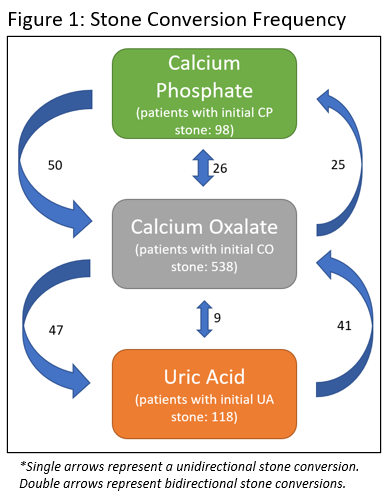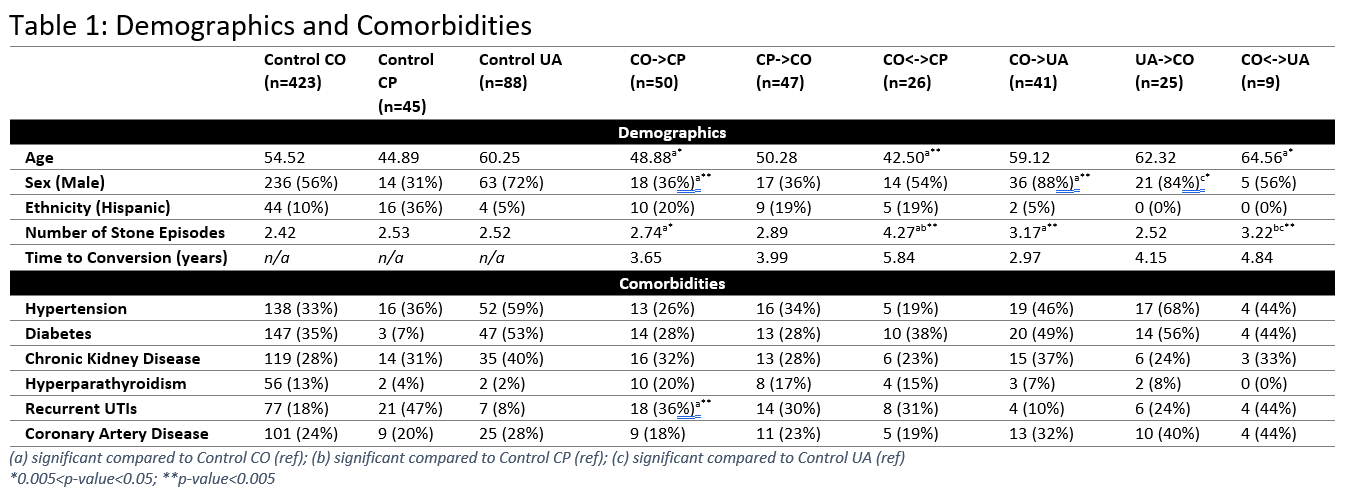Back
Poster, Podium & Video Sessions
Podium
PD50: Stone Disease: Epidemiology & Evaluation II
PD50-06: Examining Risks of Composition Conversion in Recurrent Stone Formers
Sunday, May 15, 2022
4:20 PM – 4:30 PM
Location: Room 255
Hari Nair*, Tinika Montgomery, Michael Siev, New Haven, CT, Erin Murphy, North Haven, CT, Kathryn Simmons, Piruz Motamedinia, Neera Dahl, Dinesh Singh, New Haven, CT
- HN
Podium Presenter(s)
Introduction: Most kidney stones are composed of calcium oxalate (CO), calcium phosphate (CP), uric acid (UA), or a mix. Age, gender, and urine pH are known to be associated with stone type, but factors related to conversion of one stone type to another have not been established. We examined the association between demographics and medical history of recurrent stone formers (RSFs) with conversion between CO, CP, and UA compositions.
Methods: We retrospectively reviewed all kidney stone patients from November 1994 to May 2021, and identified RSFs. Demographics, medical history, and composition were extracted through automated query and manual chart review. A stone conversion episode was defined as a change in the majority stone composition between two stone episodes separated by = 90 days. Only CO-CP and CO-UA conversions were examined. Three Non-Conversion (consistent) reference groups were included with recurrent stone episodes consistently > 50% CO, CP, or UA. Conversion groups were compared to consistent groups using Chi-squared and Kruskal-Wallis analyses.
Results: Of 10044 kidney stone patients, 809 were composition-confirmed RSFs and 199 (24.6%) of those were identified as converting between CO and CP or CO and UA--or vice versa. CO RSF who experienced a conversion had significantly more stone episodes compared those who were consistently CO. The probability of conversion was not affected by ethnicity. CO -> CP conversion or CP recurrence was most likely amongst women and younger patients (p < 0.005), while male patients changed UA -> CO (p=0.043), CO -> UA, or remained UA (p < 0.005). Notably, young patients changed between CO<->CP compositions (p < 0.005). Patients with recurrent UTI converted CO -> CP (p < 0.005). Diabetes and hypertension were not more common among CO -> UA converters (p=0.297 and p=0.125, respectively).
Conclusions: Conversion of stone composition is common. Among CO RSFs, a patient who is younger, female, or with recurrent UTIs is at greater risk of conversion to CP stones, while male sex is associated with conversion to UA stones.
Source of Funding: None


Methods: We retrospectively reviewed all kidney stone patients from November 1994 to May 2021, and identified RSFs. Demographics, medical history, and composition were extracted through automated query and manual chart review. A stone conversion episode was defined as a change in the majority stone composition between two stone episodes separated by = 90 days. Only CO-CP and CO-UA conversions were examined. Three Non-Conversion (consistent) reference groups were included with recurrent stone episodes consistently > 50% CO, CP, or UA. Conversion groups were compared to consistent groups using Chi-squared and Kruskal-Wallis analyses.
Results: Of 10044 kidney stone patients, 809 were composition-confirmed RSFs and 199 (24.6%) of those were identified as converting between CO and CP or CO and UA--or vice versa. CO RSF who experienced a conversion had significantly more stone episodes compared those who were consistently CO. The probability of conversion was not affected by ethnicity. CO -> CP conversion or CP recurrence was most likely amongst women and younger patients (p < 0.005), while male patients changed UA -> CO (p=0.043), CO -> UA, or remained UA (p < 0.005). Notably, young patients changed between CO<->CP compositions (p < 0.005). Patients with recurrent UTI converted CO -> CP (p < 0.005). Diabetes and hypertension were not more common among CO -> UA converters (p=0.297 and p=0.125, respectively).
Conclusions: Conversion of stone composition is common. Among CO RSFs, a patient who is younger, female, or with recurrent UTIs is at greater risk of conversion to CP stones, while male sex is associated with conversion to UA stones.
Source of Funding: None

.jpg)
.jpg)